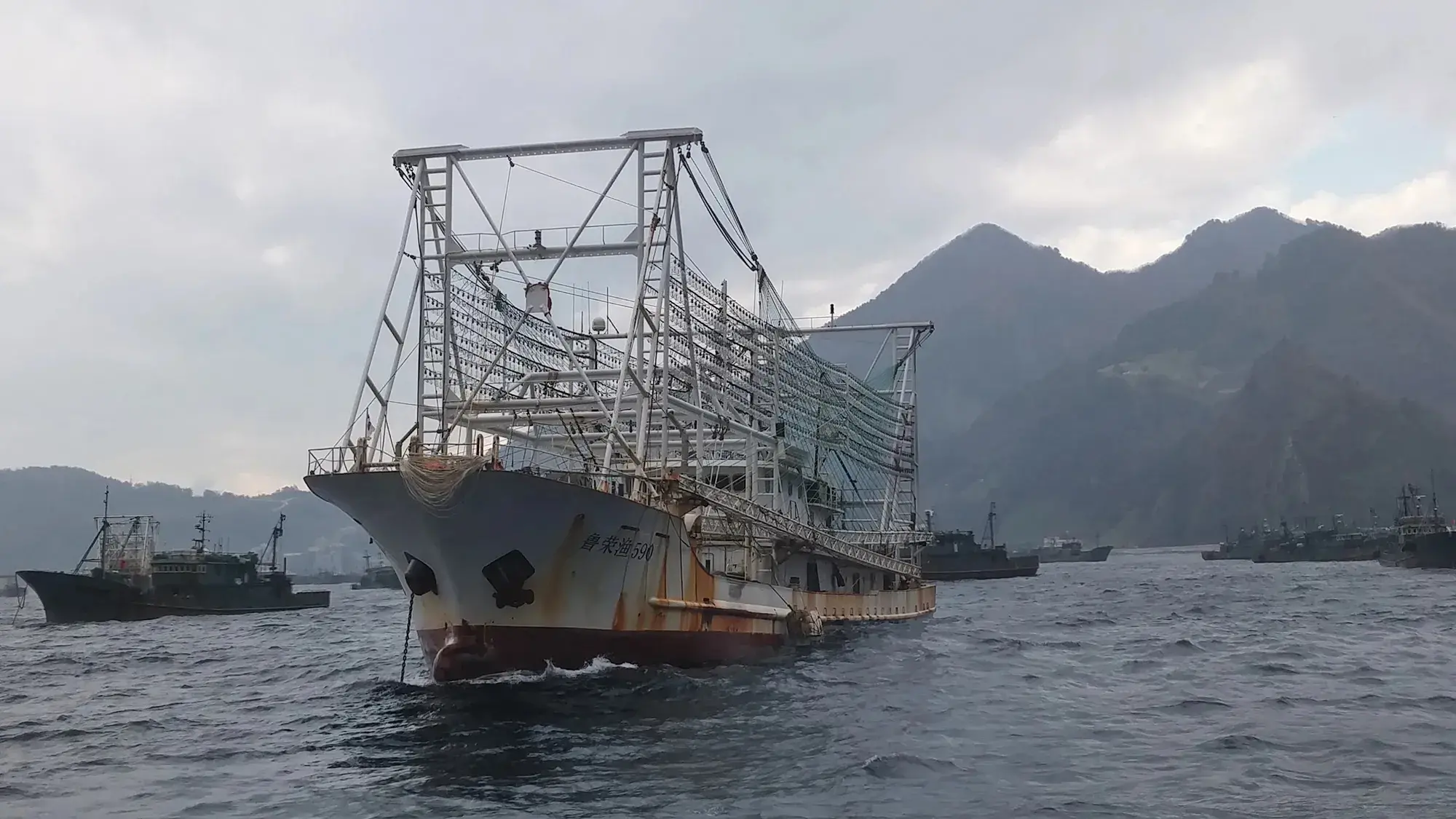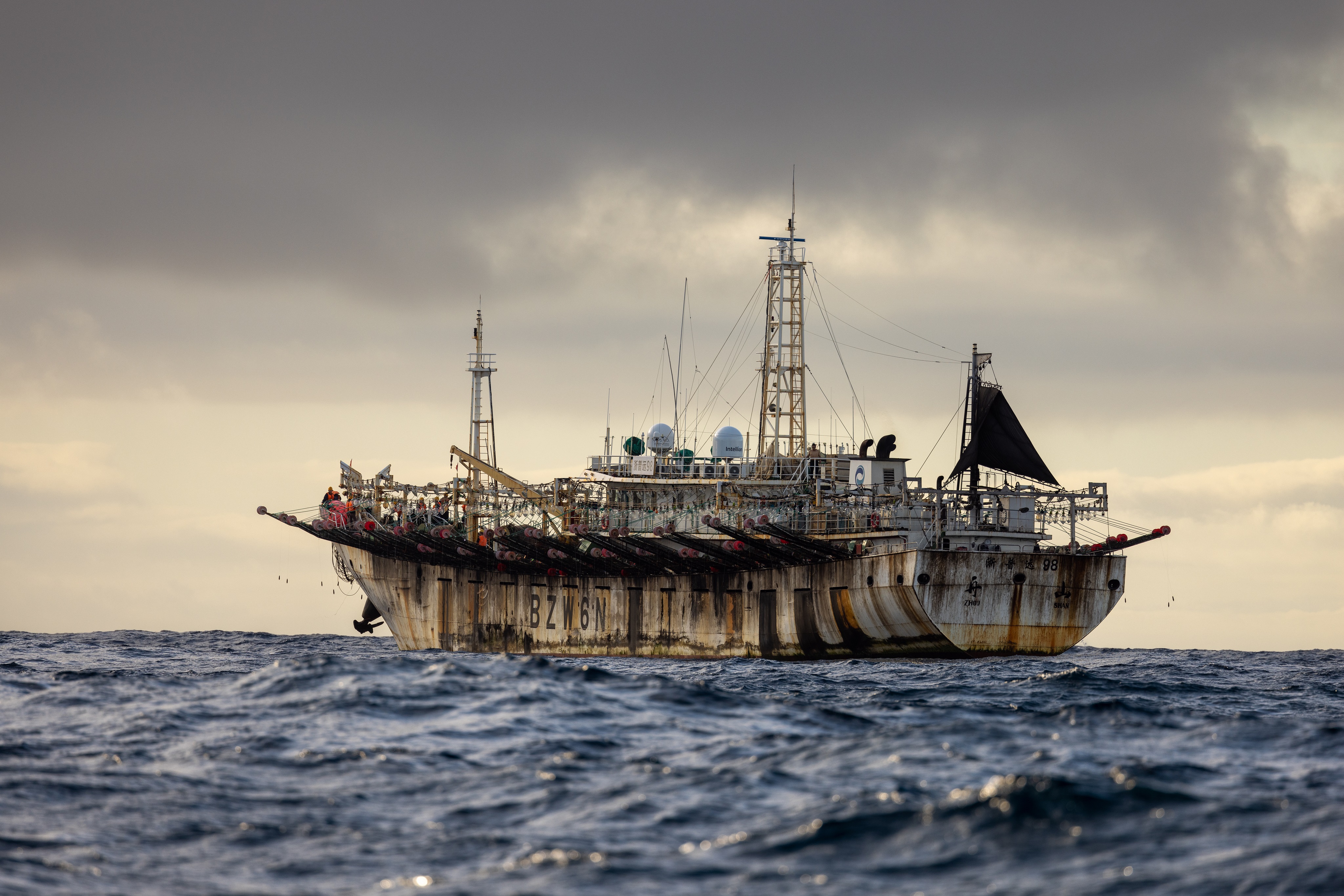Chinese forced labour taints the world’s seafood supply
In recent decades, working aggressively to expand its might, China has transformed itself into the world’s seafood superpower. This pre-eminence has come at a grave human and environmental cost.
On a cloudy morning this past April, more than eighty men and women, dressed in matching red windbreakers, stood in orderly lines in front of the train station in the city of Kashgar, in Xinjiang, China.
The people were Uyghurs, one of China’s largest ethnic minorities. They stood, with suitcases at their feet, watching a farewell ceremony held in their honour by the local government. A video of the event shows a woman wearing traditional dress pirouetting on a stage. A banner reads, “Promote Mass Employment and Build Societal Harmony.” At the end of the video, drone footage zooms out to show trains waiting to take the Uygurs away.

As a nonprofit journalism organization, we depend on your support to fund more than 170 reporting projects every year on critical global and local issues. Donate any amount today to become a Pulitzer Center Champion and receive exclusive benefits!
The event was part of a vast labour transfer programme run by the Chinese state, which forcibly sends Uyghurs across the country and puts them to work for major industries. “It’s a strategy of control and assimilation,” Adrian Zenz, an anthropologist who studies internment in Xinjiang, said. “And it’s designed to eliminate Uyghur culture.”
The programme, in turn, is part of a broader agenda intended to subjugate a historically restive people. Han Chinese are the country’s dominant ethnic group, but over half of the population of Xinjiang, a landlocked region in northwestern China, is ethnic minority, mostly Uyghur but also Kyrgyz, Tajik, Kazakh, Hui, and Mongol.
Uyghur separatists revolted throughout the 1990s and bombed police stations in 2008 and 2014. In response, China ramped up a broad programme of persecution, under which Muslim and other religious minorities in China could be detained for months or years for acts such as reciting a verse of the Qur’an at a funeral or growing a long beard. The government has also arrested Uyghurs en masse and placed them in “re-education” camps, where they are often subjected to torture, beatings, and forced sterilisation.
At the height of these programmes, between one and two million Uyghurs were detained in the camps. The US government has described the country’s actions in Xinjiang as a form of genocide.
In the early 2000s, China began transferring Uyghurs to work outside of the region as part of a programme that would later be called Xinjiang Aid. In 2014, the region’s then party secretary noted that the program would promote “full employment” and “ethnic interaction, exchange, and blending,” but Chinese academic publications have described it as a way to “crack open” the “solidified problem” of Uyghur society. The programme also provides cheap labour for China’s major industries — a need that became more acute in the seafood sector after the start of Covid-19, when lockdowns created labour shortages.
Between 2014 and 2019, according to government statistics, Chinese authorities annually relocated more than 10% of Xinjiang’s population — or over two and a half million people — through labour transfers. The effect was enormous: Between 2017 and 2019, according to the Chinese government, birth rates in Xinjiang declined by almost half. The transferred Uyghurs have been put to work harvesting cotton, digging in polysilicon factories, and producing textiles and solar panels. (Officials at China’s foreign affairs ministry did not respond to questions about the programme.)
In 2021, Congress passed the Uyghur Forced Labour Prevention Act, which declared that all goods produced “wholly or in part” by workers in Xinjiang or by ethnic minorities from the province should be presumed to have involved state-imposed forced labour and are therefore banned from entering the US. The law has had a major impact. Since last June, US Customs and Border Protection has detained more than a billion dollars of goods connected to Xinjiang, including electronics, clothing, and pharmaceuticals.
But until now one industry has largely escaped notice: the seafood industry.
The US imports roughly 80% of its seafood, and China supplies more than any other country. Half of the fish sticks served in American public schools are processed in China. But the many handoffs between fishing boats, processing plants, and exporters make it difficult for countries to track the origins of the seafood they import. Additionally, foreign journalists tend to be forbidden from freely reporting in Xinjiang, and censors scrub the Chinese internet of critical and non-official content about Uyghur labour.
To learn more about what is happening, The Outlaw Ocean Project has for the past four years conducted an extensive investigation that provides a first glimpse into the little-known system of forced Uyghur labour that gives the world much of its seafood. To verify the location of seafood-processing plants that are using forced Uyghur labour, the project’s researchers reviewed hundreds of pages of internal company newsletters, local news reports, a database of Uyghur testimonies, trade data, and satellite and cell phone imagery. They watched thousands of videos uploaded to the Internet, mostly to Douyin, another Chinese version of TikTok, and verified that the posters had initially registered in Xinjiang. Additionally, they asked specialists to review the languages used in the videos and hired investigators to visit some of the plants.
All of the available evidence reviewed by The Outlaw Ocean Project points toward a deeply troubling situation. “This discovery about seafood and the reach of the labour-transfer programme,” said Sarah Teich, a lawyer who deals with Uyghur labour issues, “ties the Uyghur abuses to consumers globally.”
The transfers usually start with a knock on the door. Then a “village work team” made up of local Party officials enters a household and engages in “thought work,” which involves urging Uyghurs to join government programmes, some of them involving relocations.
The official narrative suggests that Uyghur workers are grateful for employment opportunities, and some likely are. But a classified internal directive from Kashgar Prefecture’s Stability Maintenance Command, written in 2017, notes that people who resist work transfers can be punished with detention. Zenz told me about one woman from Kashgar who was detained for refusing a factory assignment because she had to take care of two small children. Another woman who refused a transfer was put in a cell for “non-cooperation.”
After recruits are rounded up, they get their placements. In February 2022, for example, thousands of Uyghurs were lined up at an internment camp in southern Xinjiang for a “job fair.” A video of a similar event shows people signing contracts, monitored by officials in army fatigues. Many transfers are carried out by train or plane. Xinjiang Zhongtai Group, a Fortune 500 conglomerate primarily operating in chemicals and textiles, recently organised the transfer of 100,000 workers to Hotan prefecture. (Zhongtai did not respond to requests for comment for this article.)
Sometimes, transfers are motivated by labour demands. In March 2020, the Chishan Group, one of China’s leading seafood catching and processing companies, published an internal newsletter describing what it called the “huge production pressure” caused by the pandemic. That October, Party officials from the local anti-terrorist detachment of the public security bureau and the human resources and social security bureau, which handles work transfers, met twice with executives to discuss how to find the conglomerate additional labour. Soon after, Chishan agreed to accelerate transfers to their plants. Wang Shanqiang, the deputy general manager at Chishan, said in a corporate newsletter, “The company looks forward to the migrant workers from Xinjiang arriving soon.” (The Chishan Group did not respond to requests for comment.)
*
Since the Uyghurs sent to the factories are monitored closely, one of the only ways to get a peek into their lives is through the images and videos that they post on social media. Many take selfies by the water when they first arrive in Shandong. Xinjiang is the furthest place on Earth from the ocean.
Some post Uyghur songs with mournful lyrics. These could, of course, simply be snippets of sentimental music. But researchers have argued that they might also function as ways of conveying cryptic messages of suffering, while bypassing Chinese censors.
Examples abound
One middle-aged Uyghur man, on his way to work in a Shandong seafood plant, filmed himself sitting in an airport departure lounge in March 2022 and set the footage to the song “Kitermenghu” (“I Shall Leave”). He cuts away just before lines that anybody familiar with the song would know, including: “Now we have an enemy, you should be careful.”
One woman posted a video in which she puts on a headband from a seafood company while a voiceover says, “What separates us from our parents and our hometown, leaves us in a lifetime of regret, and lures everyone in the world into slavery? Yes, money.”
In a slideshow, workers are shown packing seafood into cardboard boxes while a voiceover says, “The greatest joy in life is to defeat an enemy who is many times stronger than you, and who has oppressed you, discriminated against you, and humiliated you.”
In some videos, workers express their unhappiness in slightly less veiled terms. One video shows two Uyghur men working on a fish-packing line.
“How much do you get paid in a month?” one man asks the other.
“Three thousand,” the second responds.
“Then why are you still not happy?”
“Because I have no choice.”
*
Seafood supply chains are notoriously difficult to penetrate. To detect forced labour, companies tend to rely on firms that conduct “social audits,” in which inspectors visit a factory to make sure it complies with private labour standards.
But social audits are typically announced, which allows managers to hide Xinjiang ethnic minority workers during inspections. It is very rare for auditors to be given the opportunity to interview the workers themselves. Even when they do, workers may be hesitant to answer honestly, for fear of retribution. When Sarosh Kuruvilla, a professor of industrial relations at Cornell, analysed more than 40,000 audits from around the world, he found that almost half were unreliable. “The tool is completely broken,” he said.

In May 2022, social auditors from SGS, one of the top auditing firms, toured the Haibo factory, in Shandong, and found no evidence of forced labour at the plant. But when the Outlaw Ocean Project investigated the matter, it found that more than one hundred seventy people from Xinjiang worked at Haibo in 2021. On the same day that the auditors toured, a young Uyghur worker posted pictures of herself near the plant’s dormitories and loading bays. (“We are a company run in accordance to the law and regulations,” a representative from the Haibo plant said in an email.)
This was not an isolated incident. In its investigation, The Outlaw Ocean Project found other examples of Uyghurs who posted pictures of themselves at factories within days of those plants being cleared by social audits. It also found that half of the Chinese exporters that it had identified as tied to Uyghur labour had passed audits by leading global inspection firms.
Even some companies that are certified as “sustainable” are implicated. We found that all the seafood plants that we investigated using Xinjiang forced labour were certified by the Marine Stewardship Council. (Jo Miller, the MSC’s head of public relations, acknowledged that the company is reliant on social audits, which have “significant limitations.”)
*
In its investigation, The Outlaw Ocean Project found that at least 10 large seafood companies in China have used at least a thousand Uyghur labourers since 2018. During that time, those companies shipped more than 47,000 tons of seafood to the United States. Seafood from these plants was bought by US and Canadian importers, among them High Liner Foods. (A spokesperson for High Liner Foods said that the plant it worked with had undergone a third-party audit in September 2022.)
Because seafood can get commingled at each stage of shipping, it’s difficult to know for sure where any given batch ends up. But American companies that imported from factories using Uyghur labour sent their products to supermarkets across the country, including Walmart, Costco, Kroger, and Albertsons, which are among the top 10 largest grocers by number of stores in the US (A spokesperson for Wal-Mart said that the company “expects all our suppliers to comply with our standards and contractual obligations, including those relating to human rights.” A spokesperson for Albertsons said that they would stop purchasing seafood products from High Liner Foods. Costco and Kroger did not respond to requests for comment.)

The importers also sent seafood to Sysco, the global foodservice giant that supplies more than 400,000 restaurants in the United States alone. (A spokesperson for Sysco said that its supplier, Yantai Sanko, had undergone audits, and denied that it had ever “received any workers under a state-imposed labour transfer program.”)
Additionally, during the past five years, the US government has bought more than $200-million worth of seafood from importers tied to Uyghur labour, for use in public schools and federal prisons, and on military bases. (A spokesperson for the Department of Agriculture said that federal agencies are required to source from US waters, but watchdog groups say exemptions mean that much of the seafood actually comes from China.)
The US is not the only country importing seafood tied to Xinjiang labour. The Outlaw Ocean Project also identified seafood imports tied to Xinjiang labour in over 36 countries.
To address this situation in the US, experts say that adjustments need to be made to the federal Seafood Import Monitoring Program. The program, designed to detect and combat illegal fishing, requires importers to keep detailed records of their products. But several key species, including squid and salmon, are not included in monitoring, and the program wasn’t designed to detect forced labour and other such abuses.
Judy Gearhart, who works for the Accountability Research Center at American University, argues that the law behind the program should be expanded to force companies in China and their US buyers to provide more detailed information about workers at Chinese processing plants. Uyghur experts like Laura Murphy call for companies to undertake more effective human rights due diligence that’s designed to detect state-imposed forced labour in China. “The US is falling behind in the global race to require companies to undertake basic checks that can detect Xinjiang forced labour, and other forms of exploitation,” said Chloe Cranston of Anti-Slavery International.
Robert Stumberg, a law professor at Georgetown University, said that the law on Uyghur labour is “distinctly powerful” and that the US government has already enforced it for solar panels, auto parts, computer chips, palm oil, sugar, and tomatoes. To Stumberg, it’s obvious what now has to happen.
“Seafood,” he says, “should be next.”












